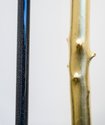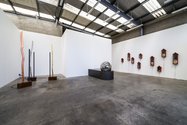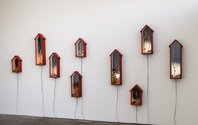Andrew Paul Wood – 7 December, 2013
The first thing encountered is three 'Measuring Devices', upright wood boughs, probably symbolic walking sticks (reflections of the artist's own), coated in gold, platinum, or copper, each subtly moving while connected to slender glass tubes full of coal. The glass tubes are topped with wads of cotton wool which simultaneously suggest a piece of laboratory apparatus and a puff of faux smoke from a coal-fired chimney.
Christchurch
Andrew Drummond
from a private site; objects
26 November - 21 December 2013
Alchemy is the art of liberating parts of the Cosmos from temporal existence and achieving perfection which, for metals is gold, and for man, longevity, then immortality and, finally, redemption. Material perfection was sought through the action of a preparation (Philosopher’s Stone for metals; Elixir of Life for humans), while spiritual ennoblement resulted from some form of inner revelation or other enlightenment (Gnosis, for example, in Hellenistic and western practices).
J. Stanton Linden, Darke Hierogliphicks: Alchemy in English literature from Chaucer to the Restoration. University Press of Kentucky. (1996). p11.
Christchurch-based sculptor Andrew Drummond is an extraordinary artist. It is a civic shame that Christchurch’s pettifogging pecksniffian and pudibond philistines prevented Drummond’s Millennium Bridge from happening. He is an alchemist with a distilled vocabulary of coal, beeswax and sphagnum moss recalling Joseph Beuys’ use of congealed fat and other materials as metaphors for stored and potential energy, and concrete memory, but Drummond transcends the Beuys’ limitation by incorporating physical movement, electric light, and flowing water to animate and unify the elements in his installations and sculptures. More recently his sculptures have evolved into inscrutable engines of exclusively and active aesthetic purpose, seeking to explore the complex relationship between the body and the land, macrocosm and microcosm. In fact, one might go so far as to suggest that Drummond is one of the last Symbolists.
In the main space at the Jonathan Smart Gallery, the first thing encountered is three Measuring Devices, upright wood boughs, probably symbolic walking sticks (reflections of the artist’s own), coated in gold, platinum, or copper, each subtly moving while connected to slender glass tubes full of coal, closely related to another sculpture For Spatial Observation. The glass tubes are topped with wads of cotton wool which simultaneously suggest a piece of laboratory apparatus and a puff of faux smoke from a coal-fired chimney.
Whatever they are measuring it is at glacial, geologically slow pace like the Türler Clock, part of which takes 25,794 years to make a single revolution. This would be entirely in keeping with a practice concerned with the relationship between the body and the land - perhaps these enigmatic devices pursue a ratio between the two.
Nearby is Ocular Device: Rotating, a 1800mm sphere of mirror-polished stainless steel spinning in a thin skin of H2O like a water feature in Shanghai airport - until you pick up on the subtle patterns and flows of light it casts on the white wall behind and you have your epiphany moment. It is the reflections and not the shiny metal ball that are the important bit, the artwork proper. The convex optical distortion of the sphere itself demands attention, like a funhouse mirror or M C Escher’s lithograph Hand with Reflecting Sphere (1935).
Because of the skin of water over the sphere it becomes very difficult to determine the direction in which the sphere is spinning, or perhaps it changes direction - this adds to the mystery and Zen quality, though it might pay to consider whether it is an environmentally sustainable work or not because I suspect the era of not worrying about such things as an aesthetic criterion may be behind us.
On the right wall are the consequence of action no’s I - IX - intricate tableaux of beeswax, sphagnum moss, coal and twigs as trees, that at first glance might seem too fussy and baroque in their gabled-like-a-cuckoo-clock glass cases, but in fact they are very spare with no excess fat to them whatsoever, like a distant descendent of Max Ernst’s late dioramas but more stylised/abstract and faintly Dr Seussian. Given that the artists big survey show at Christchurch Art Gallery in 2010 was titled Andrew Drummond: Observation / Action / Reflection, this seems vaguely suggestive. All Drummond’s work may be summed up in that exhibition title and therefore these superficially quaint-seeming works almost certainly deserve closer attention. As ever, the ephemeral, abject and organic materials represent both a trace of the earth they come from and a trace of the artist’s physical body as well - the ultimate evolution of such performance pieces as Ritual for Summer Solstice, Bones/Whirl/Skin, Onto Skin, and Body/Skin Suspension Piece in the 1970s - something made all the more poignant by the artist’s own health issues.
Hiding around the corner in the smaller gallery space is Rotating Forest: a large turned wood framed glass display case affair, divided into three cosmic zones in a hybrid of the natural and the technological. The bottom section is full of sphagnum moss (in which lights mysteriously flicker like fleeting thoughts in a brain) represents the fecund and maternal earth. The top section is the heavens with fibre optic stars. In between are gently moving pieces of wood, perhaps some sort of world forest pushing heaven and earth apart like the children of Ranginui and Papatuanuku. In terms of a popular culture that has come of age in incorporating such ideas, the effect is somewhat steampunk, somewhat magictek, but descriptive of some higher and unapproachable truth or syntax we are not privy to - perhaps some vast, overarching gnostic secret that the artist has had revealed to him, but is perhaps beyond our grasp entirely.
As with the traditional practice of alchemy, the pursuit of philosophical and spiritual perfection by the successful transformation of base matter into gold, it becomes important to meditate on Drummond’s works and assimilate them into the spirit in order for them to open up and elevate the viewer to a new level of perception. Perhaps the truth to understanding Drummond’s art is that it as much about being a spiritual experience as it is an aesthetic one.
Andrew Paul Wood











 Two Rooms presents a program of residencies and projects
Two Rooms presents a program of residencies and projects Advertising in this column
Advertising in this column



This Discussion has 0 comments.
Comment
Participate
Register to Participate.
Sign in
Sign in to an existing account.